One item I am drawn to is direct display and conversation. Monika Plioplyte holds these nonevasive traits in her art practice and the manner in which she carries herself. In recent time, there’s been an insistence to avoid frankness and honesty due to our present socio-political milieu. In Plioplyte’s artworks and photographs there’s a combination of beauty, pagan ritual, physicality, and veracity that feels fresh and unbroken. This integrity is due, in part, to her unique experience. This week the COMP Magazine took the Pink Line over to Plioplyte’s Little Village studio to discuss her youth spent in Lithuania, her time spent in the Boston area, the intersection of printmaking and performance in her practice, her various travels around the globe, and how all of these items have culminated in the creation of a series of memorable images and a distinctive life story.

Let’s set the stage through discussing your youth and early introduction to the visual arts. You grew up in Lithuania and immigrated to the Boston area in your early teens. Can you identify any early experiences or people who you see having an impact on your interest in the visual arts?
I was born in Lithuania into a family of artists and there was no doubt that’s what I wanted to do from a very early age. Ever since I can remember I would draw and paint every day. For many years now, I have been drawing a lot of inspiration from the old world – more specifically Baltic Paganism which is based on nature worshiping. Growing up in Lithuania, I was surrounded by these traditions and the practice of these customs, and have always been fascinated by rituals and mythology and how that reflects human psychology. In the 2000’s, my family and I immigrated to Boston. I ended up going to Massachusetts College of Art and Design for my BFA. While I was there, I had this gut feeling to study printmaking – which was the best choice I have ever made. Printmaking really resonated with me because it’s physical, sculptural, and performative with never-ending possibilities for experimentation and iteration. I studied under Nona Hershey and Randy Garber who are both incredible artists and printmakers and are my mentors to this day. They really shaped the way I think and use printed matter physically and conceptually. After graduating from MassArt, I traveled back to Lithuania and lived there for a year, researching and studying Baltic Pagan mythology and rituals. Later in Boston, I founded a printshop and artist collective called Iron Wolf Press that I ran for about 5 years. Eventually, I moved to Chicago in 2017 to attend an MFA Print Media program at SAIC and now I live and work here.

You studied at Mass Art, then the School of the Art Institute. You were initially drawn to printmaking. In recent time, you have been experimenting with performative elements. Can you share with us how you see these two mediums merging in your investigations?
I was always very fascinated and intimidated by performance art. I never thought it would be something I would attempt to incorporate in my own practice. However, during grad school I figured it’s my chance to step out of my comfort zone and took a performance class called “Materials in the State of Change” with Werner Herterich. I was so nervous I almost dropped it a couple of times. So glad I stayed because that class really changed everything about my practice, and freed me from all sorts of mental restraints I had about what I can or cannot do in my work.

The paper collage works and the quick performance videos and performance-based photographs I create using those paper works all merged very organically. This way of interactive making offers me a more expansive understanding of my work and raises even more questions. And that’s the space I like to be in when creating.
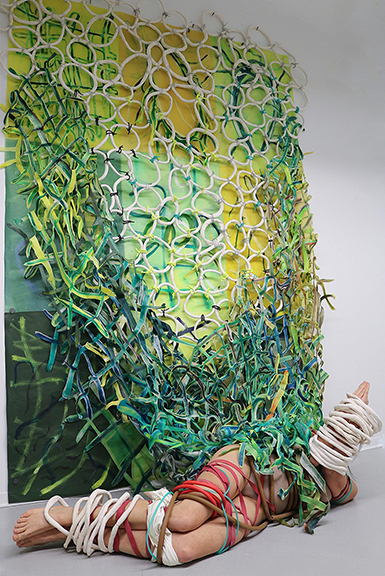
In recent time, you have been creating these mystical pieces that are worn while creating photographs. Can you walk us through your creative process? I’m curious how to how you translate the conceptual idea to sketch to final artwork.
Every day is kind of chaotic to be honest. I am really hands on and messy when I am in the studio. Sometimes I have a plan and sometimes I don’t. But that’s the fun in it for me. I prefer my studio messy because I discover new ideas that way. Like, “oh, this leftover cut out of a leg is on top of this drawing that I hate but now I kind of like that” and all the sudden I’m collaging all this stuff together. For me, it’s all about being diligent and keeping up the urgency. I love making new things with old work as well. I try to listen and follow the work and where it wants to take me. My process of searching for answers is more important than the final product. I used to struggle to find boundaries between different bodies of my work, but a few years ago I came to the conclusion that it’s all just a continuous drawing. One work leads to the next, in a constant state of flux, trapped in a cyclical time. That was very freeing for me.
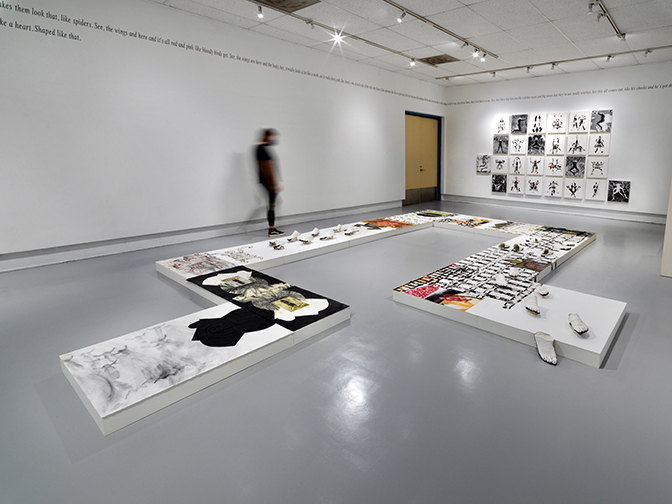
These days I only do an extensive amount of sketching if I am working on a site-specific installation. Therefore, I don’t really do much sketching for most of my artwork. I’m all about trying and failing right away. And then learning through failure about what’s to come next. If I have an idea in my head I proceed right away and make something, so now that I’m thinking about it, maybe actually most of my work is just one big sketch process. I like the unknown and l love leaving room for accidents – they always lead to something more interesting, triggering new ideas.

I see a connection between ancient art forms and folklore. Specifically, the outfits and ritual tend to appear drawn from another time. Though your studio practice is clearly contemporary, do you find inspiration from aesthetics often seen as antiquated?
Absolutely! I find inspiration through antiquated aesthetics – for example, I look at a lot of Lithuanian weavings and patterns used to decorate tablecloths, bed sheets, towels and traditional folk clothing. Lithuania has deep historical traditions in hand-woven fabrics and they are still manufactured in rural areas, representing typical fabrics closely connected to local identity and sense of belonging to a particular geographic area and cultural traditions. I like to directly reference the patterns and colors used in these traditional fabrics in my own work. I am also inspired by Baltic Pagan gods and goddesses who represented the natural phenomena such as thunder, fire, earth, sun, moon and sea followed by different offerings and ceremonies to ensure good harvest, household protection or soul purification. For pagans, land and nature are sacred. I am also interested in histories of labyrinths, witchcraft, magic, and uncanny tales from around the world. Recently, I have been researching a lot about Lilith, the first wife of Adam, who was banished from the Garden of Eden for not obeying her husband. Throughout history she has been portrayed as a demon, serpent, child eating monster, and bird goddess with clawed feet. Her story is fueling one of my bodies of work at the moment. Folklore and myths carry many mysteries and transport you to the imaginary and to the unexplained and for me that’s stimulating.

Let’s discuss the series “I for Nested Pattern” 2020-2022. There’s an otherworldliness felt here. You as subject and the selection of place is uncanny. Can you discuss what was the impetus for these works. What was the intent, and how did you select the site for the photograph?
This body of work began during the Covid lockdown and it came to me in my dreams. I saw myself covered by traditional Lithuanian weaving patterns as some sort of shield sprouting from and/or merging with nature. I actually made a sound piece about my dreams and this body of work and you can listen to it here.

More about this work – ‘I For Nested Pattern’ is an ongoing series where I document myself through photo-based performances in natural environments that resemble landscapes where I grew up and carry sentimental longing for a place or a past. Many of the photographs were taken in the flat and agricultural lands of the Midwest states – Illinois, Wisconsin, Indiana and Michigan since they remind me of the landscape of Lithuania the most. And once we were allowed to travel again, I went back to Lithuania to photograph as well. This project is still ongoing and seems to be changing throughout the three years of my working on it.

I used ‘Nested Pattern’, a term meaning pattern inside a pattern, along with the idea of the structural patterns of DNA, where information is encoded in genetic material that is the universal language for life, as a way to connect with my ancestors and the knowledge that’s been forgotten but not gone.

What do you value most in your studio practice?
I collect from the outside and work from within. My work comes from my own personal experiences that’s why I tend to use my own body so much in my practice. I believe that the personal is universal.

I value play, urgency, and the fact that I don’t need to know what the work is about right away. The work holds the answers and sometimes I only get to understand those answers many years later.
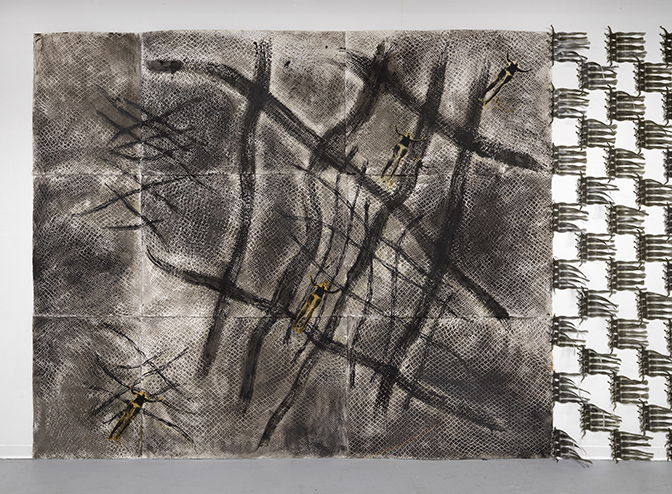
I never want to be too prescriptive about my works. I want people to have their own experiences with my works and I hope I can do that by tickling their imagination and emotional memory. I always try to allude to some psychological space or a dream state and give the viewer enough information but still provide a sense of freedom and space to find themselves in. If my work is able to do all that, then it’s a success.
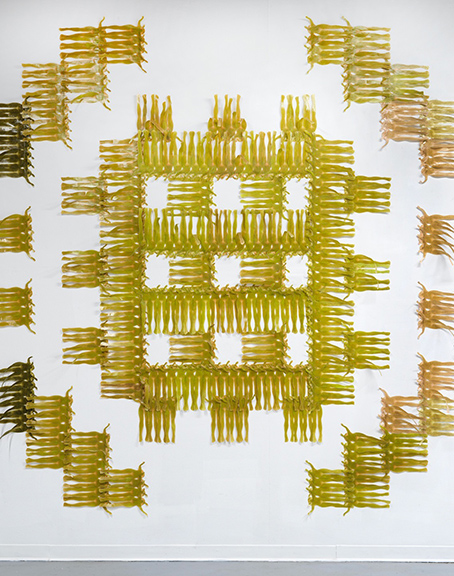
What are you currently working upon? Do you have any items you hope to complete by year’s end? What are your thoughts about 2023?
Currently I’m working on multiple on-going projects that I have been developing for a few years. They’re all connected to each other but also, they can stand on their own. I do hope to complete some aspects of these works by the end of 2023 but also, I may choose to leave some of the work open ended and come back to them after enough time has passed.

For additional information on the aesthetic practice of Monika Plioplyte, please visit:
Monika Plioplyte – http://www.monikaplioplyte.com/
Monika Plioplyte on Instagram – https://www.instagram.com/monikaplioplyte/?hl=en
Rare Visions Gallery Project – https://rarevisions.org/gravity-of-the-unsubstantiated-2021
Boundary Chicago – https://www.boundarychicago.space/monika-plioplyte
60 Wrd/Min – https://60wrdmin.org/artwork/4816833-Monika-Plioplyte.html
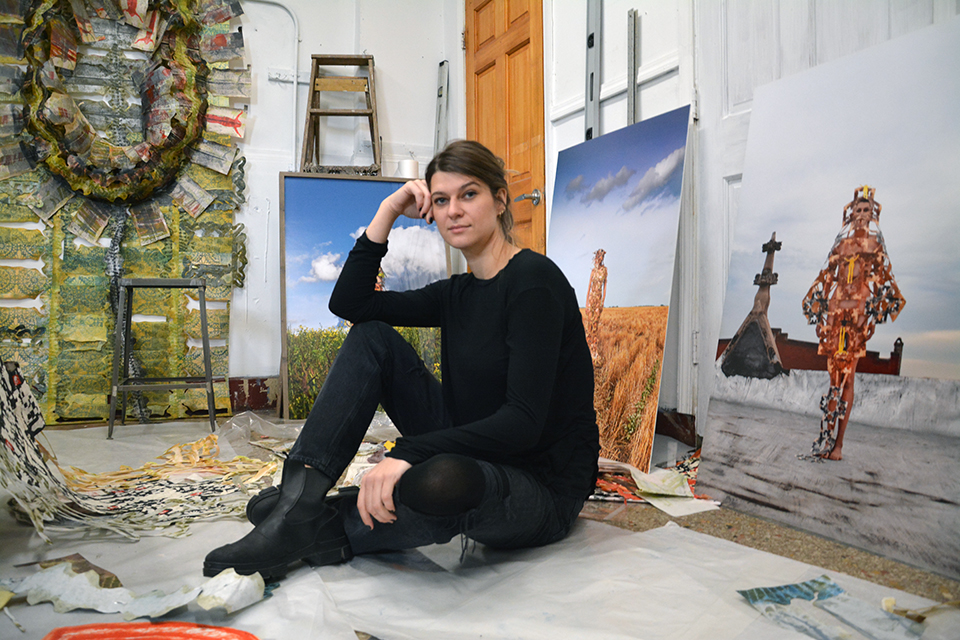
Artist interview and portrait by Chester Alamo-Costello


